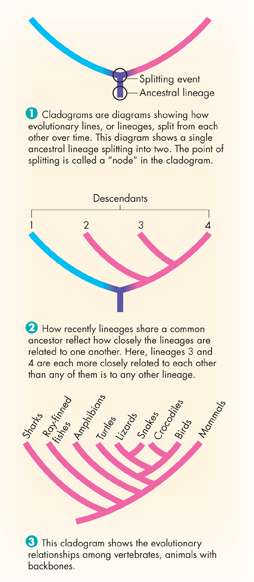Cladograms
 What is a cladogram?
What is a cladogram?
Modern evolutionary classification uses a method called cladistic analysis. Cladistic analysis compares carefully selected traits to determine the order in which groups of organisms branched off from their common ancestors. This information is then used to link clades together into a diagram called a cladogram.  A cladogram links groups of organisms by showing how evolutionary lines, or lineages, branched off from common ancestors.
A cladogram links groups of organisms by showing how evolutionary lines, or lineages, branched off from common ancestors.

FIGURE 18–7 Building a Cladogram A cladogram shows relative degrees of relatedness among lineages.
ddBuilding Cladograms To understand how cladograms are constructed, think back to the process of speciation. A speciation event, in which one ancestral species splits into two new ones, is the basis of each branch point, or node, in a cladogram. That node represents the last point at which the two new lineages shared a common ancestor. As shown in part 1 of Figure 18–7, a node splits a lineage into two separate lines of evolutionary ancestry.
Each node represents the last point at which species in lineages above the node shared a common ancestor. The bottom, or “root” of a cladogram, represents the common ancestor shared by all of the organisms in the cladogram. A cladogram's branching patterns indicate degrees of relatedness among organisms. Look at part 2 of Figure 18–7. Because lineages 3 and 4 share a common ancestor more recently with each other than they do with lineage 2, you know that lineages 3 and 4 are more closely related to each other than either is to lineage 2. The same is true for lineages 2, 3, and 4. In terms of ancestry, they are more closely related to each other than any of them is to lineage 1. Look at the cladogram shown in part 3 of Figure 18–7. Does it surprise you that amphibians are more closely related to mammals than they are to ray-finned fish? In terms of ancestry, it's true!

Table of Contents
- Formulas and Equations
- Applying Formulas and Equations
- Mean, Median, and Mode
- Estimation
- Using Measurements in Calculations
- Effects of Measurement Errors
- Accuracy
- Precision
- Comparing Accuracy and Precision
- Significant Figures
- Calculating With Significant Figures
- Scientific Notation
- Calculating With Scientific Notation
- Dimensional Analysis
- Applying Dimensional Analysis




